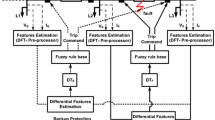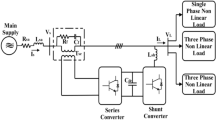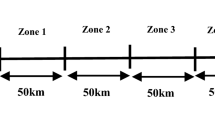Abstract
Application of typical Mamdani fuzzy inference system (MFIS) in power system protection has become a common artifact nowadays. The proposed articles on fuzzy logic-based protection initially designed the controller using typical MFIS. The related works mostly followed centroid defuzzification method. It is observed that the defuzzification method generally ensures multiple outputs. This output generally introduces lagging in detecting faults most of the time. It also delays the overall system by extending the coordination time as well. In this paper, a new FIS is discussed in terms of intelligent relaying benefits. Inverted pendulum model is considered to explain the novelty of granular differentiability. Initially, the proposed method is faster as due to its single solution-based features. This granular differentiability is considered as defuzzification method and incorporated into a new kind of fuzzy controller. The controller deals with a novel fuzzy inference system usually known as fractional fuzzy inference system. This fractional fuzzy inference system is found to respond 100% accurate and faster indeed as compared to Mamdani fuzzy inference system and reported.
Access provided by Autonomous University of Puebla. Download conference paper PDF
Similar content being viewed by others
Keywords
1 General Introduction
Manifestation of intelligent relaying in protection area nowadays has become the most discussed topics in power and energy sector. Various researches have been carried out on electrical protection by presenting artificial insights as discussed in [1,2,3,4]. Electrical fault is an unequal state that happens in any power system network. If impedance falls to exceptionally low value, then only fault appears within the system. The actual term to be associated with impedance is basically known as dynamic resistance. Hence, as impedance changes contrarily with the current, at the same time, current will increase to a most extreme surge or crest figure. In this regard, it is very much essential to find current error which implies the real value that overshoots the reference optimal current due to the colossal spikes obtained as due to impedance falls.
In this range of investigation, intelligent breaker is designed to control distributed load against over current fault as well as low voltage issues. Considering both input as well as output to the fuzzy inference system, an unique method is proposed by taking trapezoidal membership function but for only 230 V LT systems [5]. Monitoring of the fault location and operating time of a relay using intelligent algorithms like adaptive neural network and fuzzy logics was performed [6]. Reports on control methods of moving contact followed for fuzzy-based VCB were developed after thorough investigation. The method was incorporated by following adaptive fuzzy controlling algorithm [7]. Considering voltage and current as the inputs to the fuzzy engine, an algorithm was developed for quick intelligent relaying and presented prior [8]. Momesso et al. [9] have recognized a comparative study in terms of coordination time between both fuzzy and non-fuzzy-based time and current graded relaying mechanism. Other approaches also considered to create a unique kind of intelligent relaying [1, 2].
2 Literature Review and Origin of FFIS
Introducing fuzzy differential equations in any nonlinear system provokes the incorporation of nonlinear fuzzy dynamic systems (FDS) as a working model. The differential equations are considered FDE if ambiguity is present in the variable, parameters, or boundary conditions. Earlier, FDS was considered in diverse fields like [10], economics [11], fractional calculus [12], control theory [13], etc. After that, [11, 14] have discussed on production inventory system by introducing the fuzzy optimal control model. They have contributed the structure and explained how to control the model using a generalized Hukuhara differenciability in a FDS. A special kind of FDE solution strategy has been used as the name of the quasi-level-wise system based on the “e” and “g” operators [11]. Moreover, researchers [15] have proposed a new era of fuzzy derivatives known as granular derivatives based on granular differences using the functionality of horizontal MF.
Among the discussed articles, few of them have been displayed by considering current as well as voltage as two inputs to the FIS. Excluding fuzzy approach, digital signal processing (DSP) has been taken after to guarantee the dependable relay operation. Among discussed articles, one has approved the calculation utilizing Fourier investigation, but by improvising output membership function (MF) using Gaussian function and allotting it to the output segment of the FIS. Few papers included the MF as Gaussian for both input and output sections. Numerous discussed articles have displayed AI-based relaying along with the triangular MF as input. In the previous research work the major issue is with post defuzzification because of multiple solution-based output as defuzzification method followed is centroid and COG. All of the considered articles have proposed an approach to control load during fault location using typical Mamdani fuzzy inference system (MFIS). This actually creates problem while tripping with a multiple set of time frame for any specific range of fault intruded. No such algorithm is introduced to trip load instantly at any specific point connected to any feeder line.
In this paper, a novel fractional fuzzy inference system (FFIS) is discussed for intelligent relaying mechanism by introducing error and error rates of the current as input and Gaussian HMF as functional element to it. The objective of the FFIS-based intelligent relaying mechanism is to trip any load connected to a bus or feeder line more instantaneously and on a consistent basis. The yield planned here by taking both trapezoidal MF and triangular HMF. This whole plan is typified interior of an intelligent relay block and encouraged the same to a 440 V HT breaker for controlling a 440 V high tension (HT) system. A brief idea of fruitful yields of concerned intelligent approach is reported by taking an example of inverted pendulum with a brief justification. The actual novelty of this article is based on the importance of FFIS over MFIS in any intelligent relaying system for introducing fastest tripping mechanism in power system protection engineering.
This paper represents the following contributions: (1) Proposed an idea to think out of the box in implementing FFIS for intelligent relaying mechanism. (2) Presented the significance of FFIS over MFIS for intelligent relaying in brief. The entire paper organized the sections along with the fractional fuzzy inference system design, the significance of FFIS on intelligent relaying, and along with its proper application to develop one algorithm using the MATLAB environment as well. Finally, the main conclusion and discussions are discussed in Sect. 4.
3 Fractional Fuzzy Inference System Design
The process of concluding any un-encountered input is generally known as a fuzzy inference system (FIS) and plays a very significant role in designing a fuzzy system. The consequent parts of the rule base in any typical fuzzy inference system consist of fractional membership functions (MFs) is called fractional fuzzy inference system. The FFIS is considered as a kind of fuzzy if-then rule translation and known as fractional translation rule. The FFIS has been proposed as a new era of fuzzy logic-based intelligent controller which can change the perception of outcome as compared to typical FIS in future [16].
The fractional fuzzy inference system (FFIS) is actually not yet included in any of the MATLAB version as GUI. A GUI tool is very reliable in implementing, which can be included directly in a simulation model like that of typical Mamdani or Sugeno fuzzy inference system. Rather here, it is possible to work with m files only. Though this m file has some certain attributes initially to be followed for simulating the FFIS based model, those are organized in Sects. 2.1, 2.2, 2.3 and 2.4.
4 Inputs to the Fractional Fuzzy Inference System
In this case, inputs to the FFIS are considered as separate files. Overall six separate m files are required to run one FLC based on FFIS during the fuzzification process. Two files are required for the inputs, one for the rules, one for aggregation, two for the horizontal membership functions including both α—cut and β—cut separately. The membership function A € E1 corresponding to a fractional horizontal MF whose fractional index is α*A is called the fractional MF and denoted by \(\tilde{A}_{{\alpha^{*} }}\). The μ-level sets of the fractional MF \(\tilde{A}_{{\alpha^{*} }}\) are discussed in [16] (Fig. 1).
Fractional concept incorporated on membership functions and horizontal membership functions [16]
5 Development of Learning Rules for FFIS
Fractional fuzzy inference system is not much accustomed with the MATLAB environment, and thus, in-built tools are not easy to get. Thus, to introduce rules within the controller, it is necessary to develop rules using another separate m file. In this case also, rules are designed by implementing if-then concept.
6 Output of the Fractional Fuzzy Inference System
Output of the fuzzy engine is different as compared to the typical membership function followed in case of Mamdani FIS. In case of Mamdani, the concerned horizontal function usually ensures multiple ambiguous crisp outputs. Whereas, Fig. 2 explains the benefit of implementing horizontal membership function for FFIS over the multiple solution defuzzification-based MFIS.
a Typical inference result of a fuzzy rule. b The fractional inference result of a fuzzy rule represented by a fractional horizontal MF [16]
In Fig. 2, the ith rule is clearly shown in two situations with respect to the antecedent and consequent parts, respectively. Figure 2a shows the ith rule inference result where the consequent part of the MF is cut by μi*. Again in Fig. 2b, it is shown that the consequent part of the horizontal MF is not only clipped by μi*, but also by the fractional index.
7 Defuzzification Process
The overall defuzzification process in case of a fractional fuzzy inference system depends on many definitions and proofs explained in [16]. In Fig. 1, it is very clear that since α* fractional index cuts the MF from the bottom edges, defuzzification of fractional MF ensures an output that is directly proportional to the nature of the level of µ* in all respect. This indicates that both are decreasing accordingly. It is also observed that since fractional membership function is cut by β* from the top edges, the nature of the crisp output is inversely proportional to the level of µ*, which means that output increases if the level of µ* decreases. From Fig. 3, it is clear that the output MF of the FFIS is a fraction of the MFs belongs to Mamdani’s FIS. The output of the FFIS coincides along with the output of Mamdani’s FIS till the fractional indices consider the integer number as unity, i.e., \(\alpha^{*}_{{B_{i} }} = 1\). So, here in this case due to these fractional indices, FFIS ensures a better defuzzified output as compared to MFIS with more improved ambiguous output as shown in Fig. 3, especially the aggregation portion.
Comparative analysis in terms of Mamdani FIS and fractional FIS defuzzification outcome is presented based on rule consequences and aggregation [16]
8 Benefits of Implementing FFIS in Intelligent Relaying
In the case of the relaying mechanism, the most vital factor that ensures the best performance is the coordination time. Since this research is still an ongoing process and comparative case studies by considering typical Mamdani fuzzy inference system and fractional fuzzy inference system is not possible to present in this chapter. An alternative study is considered for establishing the efficiency of the concerned technique and discussed here in this paper. This can be easily explained by taking an example of inverted pendulum model as discussed in [16]. In Fig. 4, if the plot between u(t) versus time is considered, then it is very clear that a red-colored mark near to 3 s coordinate is obtained with an exact solution comprises single output. This ambiguous output from fuzzy engine ensures the plot between Ø(t) versus time with a very stable controlled trajectory angle. The comparative study has been carried out in [16], using MFIS and Larsen FIS. This stable control ensures a better transient time and far improved indeed.
Now in case of any re-striking complex wave generates during any electrical fault, the novelty of fractional fuzzy inference system automatically improves the overall coordination time by reducing transient period and sub transient period as well. Hence, it will take lesser time to achieve a stable error and therefore assist the breaker to trip the overall system with a very fast operation based on highly improved coordination time.
The practical significance of this FFIS-based intelligent relaying system is to improvise delay in the fuzzy-based intelligent relaying. It will be a big finding to the way for having one solution to get rid of catastrophic fault actually in power system protection engineering. Sometimes, it is also very much necessary to save the aging factors of any equipment in case of multiple restriking voltages due to unstable supply system or might be something very big. Looking to the future science, it might be possible to think of incorporating protection devices against lighting strike after few decades from now onwards.
9 Conclusion and Discussion
In this paper, it is clearly observed and discussed regarding the benefits of FFIS over MFIS in the case of intelligent relaying mechanism. Nowadays, it is very true that in relaying mechanism due to incorporation of AI it is very difficult to control the coordination time due to some delay in the system. That is why implication of granular-based FFIS has been discussed and summarized as follows:
-
1.
In this article, the application of novel concept proposed in [16] has been discussed in terms of its significance in intelligent relaying based on [17, 18].
-
2.
The fractional fuzzy inference system helps in reducing the transient time of symmetrical waveforms and thus trip the system much faster as compared to other typical fuzzy engine.
-
3.
In case of designing any intelligent relaying mechanism using FFIS, what are the steps to be followed to achieve the successful result has been discussed in this article.
References
Lee, S.J., Liu, C.C.: Intelligent approach to coordination identification in distance relaying. In: Proceedings of International Conference on Intelligent System Application to Power Systems, pp. 62–67. IEEE (1996)
Li, K., Lai, L., David, A.: Stand alone intelligent digital distance relay. IEEE Trans. Power Syst. 15(1), 137–142 (2000)
Samonto, S., Pal, S., Banerjee, S.: FIS incorporated microcontroller based MCB. In: 2016 International Conference on Intelligent Control Power and Instrumentation (ICICPI), pp. 132–136. IEEE (2016)
Liu, Z., Duan, X., Liao, M., Zou, J., Ge, G., Lv, G.: Investigation on information monitoring technology for intelligent vacuum circuit breaker. In: 2016 27th International Symposium on Discharges and Electrical Insulation in Vacuum (ISDEIV), vol. 2, pp. 1–4. IEEE (2016)
Mandal, S.K., Pal, S., Samonto, S.: Distributed load control using flc based mcb. In: 2015 IEEE International Conference on Electrical, Computer and Communication Technologies (ICECCT), pp. 1–7. IEEE (2015)
Kezunovic, M.: Use of intelligent techniques for analysis of faults and protective relay operations. In: 2007 IEEE Power Engineering Society General Meeting, pp. 1–3. IEEE (2007)
Li, T.H., Fang, C.E., Li, W., Zhou, L.l.: Investigation on controlling techniques of moving contact behaviors for vacuum circuit breaker based on fuzzy control. In: 2010 Asia-Pacific Power and Energy Engineering Conference, pp. 1–4. IEEE (2010)
Panda, G., Mishra, R.: Fast intelligent relaying using fuzzy logic technique. In: Proceedings of IEEE International Conference on Industrial Technology 2000 (IEEE Cat. No. 00TH8482), vol. 2, pp. 159–163. IEEE (2000)
Momesso, A.E., Bernardes, W.M.S., Asada, E.N.: Fuzzy adaptive setting for time-current-voltage based over current relays in distribution systems. Int. J. Electr. Power Energy Syst. 108, 135–144 (2019)
Najariyan, M., Farahi, M.H., Alavian, M.: Optimal control of HIV infection by using fuzzy dynamical systems. J. Math. Comput. Sci. 2(4), 639–649 (2011)
Khatua, D., De, A., Maity, K., Kar, S.: Use of “e” and “g” operators to a fuzzy production inventory control model for substitute items. RAIRO-Oper. Res. 53(2), 473–486 (2019)
Mazandarani, M., Najariyan, M.: Differentiability of type-2 fuzzy number-valued functions. Commun. Nonlinear Sci. Numer. Simul. 19(3), 710–725 (2014)
Long, H.V., Son, N.T.K., Tam, H.T.T.: The solvability of fuzzy fractional partial differential equations under caputo gh-differentiability. Fuzzy Sets Syst. 309, 35–63 (2017)
Najariyan, M., Farahi, M.H.: A new approach for solving a class of fuzzy optimal control systems under generalized hukuhara differentiability. J. Franklin Inst. 352(5), 1836–1849 (2015)
Mazandarani, M., Pariz, N., Kamyad, A.V.: Granular differentiability of fuzzy-number-valued functions. IEEE Trans. Fuzzy Syst. 26(1), 310–323 (2018)
Mehran, M., Xiu, L.: Fractional fuzzy inference system: the new generation of fuzzy inference system. IEEE Access. 8, 126066–126082 (2020)
Landowski, M.: Method with horizontal fuzzy numbers for solving real fuzzy linear systems. Soft Comput. 23(12), 3921–3933 (2019)
Samonto, S., Kar, S., Pal, S., Sekh, A.A., Castillo, O., Park, G.K.: Best fit membership function for designing fuzzy logic controller aided intelligent overcurrent fault protection scheme. Int. Trans. Electr. Energy Syst. 31(5), p.e12875 (2021)
Mazandarani, M., Pariz, N., Kamyad, A.V.: Granular differentiability of fuzzy-number-valued functions. IEEE Trans. Fuzzy Syst. 26(1), 310–323 (2018)
Acknowledgements
We are very much thankful to Dr. Meheran Mazandarani from Tsinghua University, Shenzhen, China. Dr. Meheran Mazandarani has proposed FFIS and authored [15, 16, 19]. His support in carrying out this research is still on the way. It is an honor to have such a great friend like him with such an outstanding novel thought.
Author information
Authors and Affiliations
Editor information
Editors and Affiliations
Rights and permissions
Copyright information
© 2022 The Author(s), under exclusive license to Springer Nature Singapore Pte Ltd.
About this paper
Cite this paper
Samonto, S., Khatua, D., Pal, S., Kar, S., Sekh, A.A. (2022). Significance of Fractional Fuzzy Inference System in Intelligent Relaying Mechanism. In: Bhaumik, S., Chattopadhyay, S., Chattopadhyay, T., Bhattacharya, S. (eds) Proceedings of International Conference on Industrial Instrumentation and Control. Lecture Notes in Electrical Engineering, vol 815. Springer, Singapore. https://doi.org/10.1007/978-981-16-7011-4_19
Download citation
DOI: https://doi.org/10.1007/978-981-16-7011-4_19
Published:
Publisher Name: Springer, Singapore
Print ISBN: 978-981-16-7010-7
Online ISBN: 978-981-16-7011-4
eBook Packages: EngineeringEngineering (R0)








